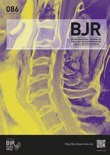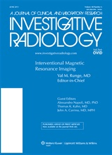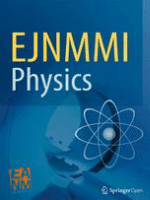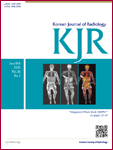
Abdominal Radiology
Scope & Guideline
Championing Excellence in Abdominal Imaging
Introduction
Aims and Scopes
- Advanced Imaging Techniques:
The journal emphasizes the development and application of advanced imaging modalities such as MRI, CT, ultrasound, and PET, particularly focusing on their diagnostic accuracy and clinical utility. - Radiomics and Machine Learning:
An increasing focus on the integration of radiomics and machine learning techniques to extract quantitative imaging features for predicting disease outcomes, treatment responses, and aiding in diagnosis. - Clinical Applications in Oncology:
A significant portion of the research is dedicated to the role of imaging in cancer detection, staging, and treatment response evaluation, particularly for hepatobiliary, gastrointestinal, and urological cancers. - Interventional Radiology:
The journal covers advancements in interventional techniques, including percutaneous ablation and transarterial therapies, highlighting their efficacy and safety in managing abdominal conditions. - Multimodal Imaging Approaches:
Research often explores the benefits of combining various imaging modalities (e.g., MRI with PET/CT) to enhance diagnostic accuracy and treatment planning. - Patient-Centered Imaging Protocols:
Studies focused on optimizing imaging protocols to improve patient outcomes, reduce invasiveness, and enhance the quality of imaging studies are frequently published.
Trending and Emerging
- Integration of Artificial Intelligence (AI):
There is a growing trend in the use of AI and machine learning methodologies to enhance diagnostic accuracy, automate image analysis, and predict patient outcomes based on imaging data. - Radiomics and Personalized Medicine:
The focus on radiomics, which involves extracting large amounts of quantitative data from medical images, is increasing as researchers aim to personalize treatment plans and improve prognostic accuracy. - Advanced Imaging Techniques for Liver Diseases:
Research specifically targeting liver disease imaging, including hepatocellular carcinoma, is trending, with studies exploring novel MRI techniques and contrast agents. - Patient Safety and Quality Improvement:
There is an emerging emphasis on patient safety, including studies assessing the impact of imaging protocols on patient outcomes and the reduction of unnecessary procedures. - Multimodal Imaging for Comprehensive Assessments:
The trend towards multimodal imaging approaches is growing, with studies investigating the combined use of different imaging techniques for better diagnostic and treatment planning. - Telemedicine and Remote Imaging:
The adaptation of telemedicine in radiology, particularly in light of the COVID-19 pandemic, is emerging as a significant theme, focusing on remote imaging consultations and second opinions.
Declining or Waning
- Conventional Imaging Techniques:
Research focused on traditional imaging techniques without the integration of advanced technologies or analysis methods has become less prevalent as the field moves towards more sophisticated imaging modalities. - Basic Descriptive Studies:
There has been a noticeable decline in studies that provide basic descriptive analyses of imaging findings without incorporating advanced statistical methods or machine learning approaches. - Single-Center Studies:
The journal has seen fewer single-center studies, with a shift towards multicenter collaborations that enhance the generalizability of findings and involve larger patient populations. - Non-Oncological Applications:
Research exploring non-oncological applications of abdominal imaging, such as routine assessments for benign conditions, has diminished as the focus has increasingly shifted towards oncology-related studies. - General Radiology Education:
Studies aimed at general radiology education and training have waned, as the emphasis has moved towards specialized training in abdominal radiology and advanced imaging techniques.
Similar Journals

BRITISH JOURNAL OF RADIOLOGY
Transforming Clinical Insights with Cutting-Edge ResearchBritish Journal of Radiology is a leading peer-reviewed journal published by the British Institute of Radiology, dedicated to advancing the field of radiology, nuclear medicine, and imaging. With a prestigious history dating back to 1945, this journal is at the forefront of disseminating cutting-edge research and innovations that significantly impact clinical practice. Currently enjoying a Q1 ranking in the field of radiology and Q2 in general medicine for 2023, it is recognized for its rigorous standards and high-quality content, ranking #87 out of 333 in Scopus for specialties related to Medicine, Radiology, Nuclear Medicine, and Imaging, placing it in the 74th percentile. Researchers, professionals, and students are encouraged to engage with the latest findings and comprehensive reviews presented within its pages, which contribute not only to academic discourse but also to the evolution of practice in the wider medical community.

INVESTIGATIVE RADIOLOGY
Pioneering Innovations in Radiology and BeyondINVESTIGATIVE RADIOLOGY, published by Lippincott Williams & Wilkins, is a premier peer-reviewed journal dedicated to disseminating innovative research in the fields of radiology, nuclear medicine, and imaging. With a notable impact factor underscored by its impressive ranking—10th out of 333 in its category, positioning it within the 97th percentile—this journal serves as a vital resource for researchers, professionals, and students eager to stay at the forefront of advancements from 1966 to 2024. Although it does not offer open access, the high-quality studies and reviews found within its pages contribute significantly to the understanding and application of modern imaging techniques. Recognized for its Q1 status in both miscellaneous medicine and radiology specializations, INVESTIGATIVE RADIOLOGY continues to play an essential role in shaping the future of diagnostic and therapeutic imaging.

Japanese Journal of Radiology
Advancing the Frontiers of Medical ImagingThe Japanese Journal of Radiology, published by SPRINGER, serves as a premier platform for disseminating cutting-edge research and clinical advancements in the fields of radiology, nuclear medicine, and imaging. With an ISSN of 1867-1071 and E-ISSN 1867-108X, this journal has established itself as a vital resource for practitioners, researchers, and students alike. Renowned for its high-quality peer-reviewed articles, it currently enjoys a respectable impact factor within the Q2 category of Scopus rankings, placing it in the 69th percentile among 333 journals in its field. The journal has seen consistent convergence of research from 2009 to 2024, further underscoring its commitment to advancing the understanding of radiological practices. Importantly, the journal offers Open Access options to facilitate widespread dissemination of knowledge, ensuring that vital research reaches its audience without barriers. Addressed in Japan, the Japanese Journal of Radiology plays a critical role in enhancing the global discourse on medical imaging, making it an essential resource for anyone engaged in this dynamic field.

EJNMMI Physics
Elevating Knowledge in Medical Physics and Imaging Technologies.EJNMMI Physics, the premier journal for advancements in nuclear medicine and imaging, is published by Springer in Switzerland and has been an open-access outlet since 2014, allowing for broad dissemination of critical research findings. With an ISSN of 2197-7364, the journal aims to bridge the gap between state-of-the-art physics and practical applications in biomedical engineering and radiology. Its impressive Q1 ranking in multiple categories, including Biomedical Engineering, Instrumentation, Radiation, and Radiology, Nuclear Medicine and Imaging, exemplifies its significant impact in the field. The journal boasts exceptional metrics with Scopus rankings placing it in the top echelons across disciplines, including a 6th position out of 58 in Radiation, and serves as an essential resource for researchers, professionals, and students who are eager to contribute to and stay informed about cutting-edge scientific advancements. With a broadening scope until 2024, EJNMMI Physics is an indispensable tool for those dedicated to pushing the boundaries of knowledge in medical physics and imaging technologies.

Radiologie
Advancing Imaging Science for Better Patient OutcomesRadiologie, published by SPRINGER HEIDELBERG, is an emerging journal dedicated to the fields of radiology, nuclear medicine, and imaging. With an ISSN of 2731-7048 and E-ISSN 2731-7056, this journal does not currently offer open access, providing a traditional yet respected platform for scholarly communication. Founded in 2022, it aims to advance the understanding of cutting-edge imaging techniques and their applications in clinical practice, contributing to improvements in diagnostic accuracy and patient care. Despite its recent establishment, Radiologie is positioned within the Q4 quartile category, reflecting its developing presence in the academic landscape, with a current Scopus rank of #231 out of 333 in its category. The journal serves as a vital resource for researchers, professionals, and students seeking to stay abreast of the latest developments in radiological science, imaging technology, and their clinical implications, ensuring ongoing engagement and advancement in this critical area of healthcare.

DENTOMAXILLOFACIAL RADIOLOGY
Pioneering Research in Maxillofacial RadiologyDentomaxillofacial Radiology, published by the British Institute of Radiology, serves as a premier journal in the realm of radiology, focusing specifically on imaging techniques and methodologies that are essential for the diagnosis and treatment in the dental and maxillofacial regions. Since its inception in 1972, the journal has maintained a rigorous standard for publishing impactful research, currently boasting an impressive impact factor that underscores its relevance and authority in the field. With categorization in Q1 for both Dentistry (Miscellaneous) and Otorhinolaryngology, as well as Q2 for Medicine (Miscellaneous), this journal supports professionals and students alike through the dissemination of cutting-edge research. Although it does not currently operate as an open-access platform, it is accessible for a wide audience eager to engage with the latest advancements in radiology, nuclear medicine, and imaging. By bridging the gap between clinical practice and innovative research, Dentomaxillofacial Radiology continues to be an invaluable resource for academics and practitioners seeking to enhance their expertise and improve patient outcomes in a rapidly evolving field.

EUROPEAN JOURNAL OF RADIOLOGY
Enhancing Knowledge, Improving Imaging PracticesThe European Journal of Radiology, published by Elsevier Ireland Ltd, is a premier peer-reviewed journal in the fields of radiology, nuclear medicine, and imaging. Established in 1981, it has carved a significant niche within the academic community, showcasing innovative research that enhances medical imaging practices and improves patient care. With an impressive ranking in the Q1 category for both Medicine (miscellaneous) and Radiology, Nuclear Medicine, and Imaging in 2023, the journal is recognized globally for its commitment to advancing scientific knowledge and improving imaging methodologies. The journal's Scopus ranking of #60/333, placing it in the 82nd percentile, underlines its reputation for high-quality research and scholarly contributions. While traditionally a subscription-based journal, it continually evolves to meet the demands of the academic landscape, aiming to bridge the gap between research and clinical practice. Researchers, healthcare professionals, and students alike can benefit from exploring its extensive archives and current publications, which are curated to foster education and innovation in the medical imaging domain.

Imaging
Elevating Standards in Imaging ResearchImaging, published by AKADEMIAI KIADO ZRT, is an esteemed open-access journal dedicated to the field of medical imaging, established in 2020. With an E-ISSN of 2732-0960 and based in Budapest, Hungary, this journal provides a vital platform for the dissemination of cutting-edge research and advancements in imaging techniques, especially in the realms of radiology, nuclear medicine, and ultrasound technology. While currently positioned in the Q4 category across multiple medical specialties, the journal continues to strive for improvements in visibility and impact, contributing to the evolving discourse in medical imaging. The journal aims to facilitate an inclusive and collaborative environment for researchers, professionals, and students, inviting them to share their findings and insights to enhance the field's development. With open-access availability since its inception, Imaging ensures free and easy access to its content, fostering a greater understanding and appreciation of innovative imaging practices worldwide.

Insights into Imaging
Advancing the Frontiers of Medical ImagingInsights into Imaging is a prominent open-access journal published by SPRINGER WIEN, specializing in the dynamic fields of radiology, nuclear medicine, and imaging, with its ISSN 1869-4101. Established in 2012, the journal has established itself as a leading platform for disseminating high-quality research and innovative findings, currently holding a prestigious Q1 ranking in its category as of 2023. With an impressive Scopus rank of #42 out of 333 in the medicine discipline, the journal is positioned in the 87th percentile, reflecting its significance and influence in the academic community. Based in Germany, Insights into Imaging not only provides unrestricted access to research but also aims to bridge the gap between scientific inquiry and clinical application, making it an essential resource for researchers, professionals, and students engaged in advancing imaging technologies and practices. The journal’s commitment to fostering knowledge exchange ensures that it remains a critical contributor to the evolving landscape of medical imaging, with articles available from 2012 through 2024.

KOREAN JOURNAL OF RADIOLOGY
Connecting Clinicians and Researchers in RadiologyKorean Journal of Radiology (ISSN: 1229-6929, E-ISSN: 2005-8330), published by the Korean Society of Radiology, stands as a leading international platform for the dissemination of high-quality research and advancements in the fields of radiology, nuclear medicine, and imaging. With a remarkable impact factor and ranked in the Q1 quadrant in its category, this journal showcases cutting-edge studies, clinical investigations, and comprehensive reviews that significantly contribute to the understanding and practice of medical imaging. Researchers, clinicians, and students alike will find the journal an invaluable resource, featuring innovative methodologies, case studies, and essential updates in imaging technology. Since its inception in 2000 and continuing through 2024, the Korean Journal of Radiology remains dedicated to promoting excellence and fostering collaborative research within the global radiology community, underscoring the importance of imaging in modern medicine.